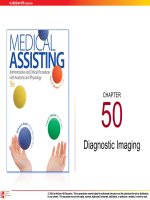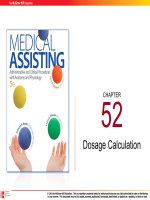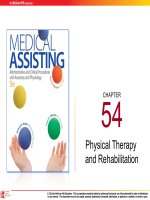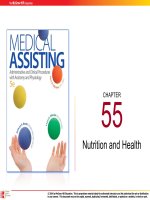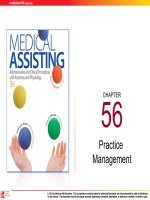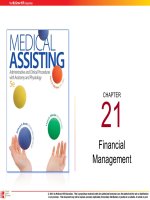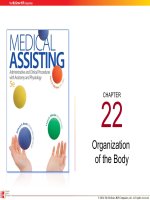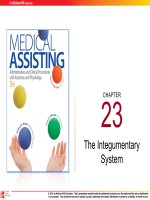Medical assisting Administrative and clinical procedures (5e) Chapter 47 Processing and testing urine and stool samples
Bạn đang xem bản rút gọn của tài liệu. Xem và tải ngay bản đầy đủ của tài liệu tại đây (1.01 MB, 53 trang )
CHAPTER
47
Processing and
Testing Urine and
Stool Samples
© 2014 by McGraw-Hill Education. This is proprietary material solely for authorized instructor use. Not authorized for sale or distribution
in any manner. This document may not be copied, scanned, duplicated, forwarded, distributed, or posted on a website, in whole or part.
47-2
Learning Outcomes
47.1 Discuss the role of the medical assistant in
collecting, processing, and testing urine and
stool samples.
47.2 Carry out procedures for following guidelines
when collecting urine specimens.
© 2014 by McGraw-Hill Education. This is proprietary material solely for authorized instructor use. Not authorized for sale or distribution
in any manner. This document may not be copied, scanned, duplicated, forwarded, distributed, or posted on a website, in whole or part.
47-3
Learning Outcomes
47.3 Describe the process of urinalysis and its
purpose.
47.4 Carry out the proper procedure for collecting
and processing a stool sample for fecal
occult blood testing.
© 2014 by McGraw-Hill Education. This is proprietary material solely for authorized instructor use. Not authorized for sale or distribution
in any manner. This document may not be copied, scanned, duplicated, forwarded, distributed, or posted on a website, in whole or part.
47-4
Introduction
• Proper collection of urine and stool specimens
key to diagnosing
• Medical assistant
– Learn about urine and fecal specimens
– Instruct or assist patient in collection of a
specimen
– Constituents of urine samples
– Chain of custody for drug screening
© 2014 by McGraw-Hill Education. This is proprietary material solely for authorized instructor use. Not authorized for sale or distribution
in any manner. This document may not be copied, scanned, duplicated, forwarded, distributed, or posted on a website, in whole or part.
47-5
The Role of the Medical Assistant
• Collect, process, and test
urine samples
• Knowledge necessary
– Anatomy and physiology of
kidneys
– How urine is formed
– Normal components of urine
© 2014 by McGraw-Hill Education. This is proprietary material solely for authorized instructor use. Not authorized for sale or distribution
in any manner. This document may not be copied, scanned, duplicated, forwarded, distributed, or posted on a website, in whole or part.
47-6
Role of the Medical Assistant
• Potentially hazardous waste
– Standard Precautions
– PPE as needed
– Handle and dispose of specimens properly
– Dispose of used supplies and equipment
properly
– Sanitize, disinfect, and/or sterilize reusable
equipment
© 2014 by McGraw-Hill Education. This is proprietary material solely for authorized instructor use. Not authorized for sale or distribution
in any manner. This document may not be copied, scanned, duplicated, forwarded, distributed, or posted on a website, in whole or part.
47-7
Apply Your Knowledge
What does the medical assistant need to know
related to collecting, processing, and testing urine
specimens?
ANSWER: The medical assistant needs to
know the anatomy and physiology of the
urinary system, how urine is formed, and
normal components of urine.
© 2014 by McGraw-Hill Education. This is proprietary material solely for authorized instructor use. Not authorized for sale or distribution
in any manner. This document may not be copied, scanned, duplicated, forwarded, distributed, or posted on a website, in whole or part.
47-8
Obtaining Urine Specimens
• General guidelines
– Follow procedure for specified test
– Use appropriate specimen container
– Label specimen container correctly
– Explain the procedure to patient
– Wash your hands before and after; wear
gloves
– Complete paperwork
© 2014 by McGraw-Hill Education. This is proprietary material solely for authorized instructor use. Not authorized for sale or distribution
in any manner. This document may not be copied, scanned, duplicated, forwarded, distributed, or posted on a website, in whole or part.
47-9
Obtaining Urine Specimens (cont.)
• Instruct patients
– Test-specific
– General
• Use correct container
• Do not discard preservative
• Refrigerate the collection
container
• Keep lid on the container
© 2014 by McGraw-Hill Education. This is proprietary material solely for authorized instructor use. Not authorized for sale or distribution
in any manner. This document may not be copied, scanned, duplicated, forwarded, distributed, or posted on a website, in whole or part.
47-10
Specimen Types
• Quantitative analysis
• Qualitative analysis
• Vary in
– The method used to collect a specimen
– The time frame in which to collect a specimen
• Follow procedure exactly
© 2014 by McGraw-Hill Education. This is proprietary material solely for authorized instructor use. Not authorized for sale or distribution
in any manner. This document may not be copied, scanned, duplicated, forwarded, distributed, or posted on a website, in whole or part.
47-11
Specimen Types (cont.)
• Random urine specimen
– Most common
– Obtained any time during the day
• First morning specimen
– Collected after a night’s sleep
– Contains greater concentration of substances
© 2014 by McGraw-Hill Education. This is proprietary material solely for authorized instructor use. Not authorized for sale or distribution
in any manner. This document may not be copied, scanned, duplicated, forwarded, distributed, or posted on a website, in whole or part.
47-12
Specimen Types (cont.)
• Clean-catch midstream
– Used for culturing urine
– External genitalia must be cleansed
– A small amount of urine is discarded prior to
collecting specimen
© 2014 by McGraw-Hill Education. This is proprietary material solely for authorized instructor use. Not authorized for sale or distribution
in any manner. This document may not be copied, scanned, duplicated, forwarded, distributed, or posted on a website, in whole or part.
47-13
Specimen Types (cont.)
• Timed urine specimen
– Discard first specimen
– Collect all urine for specified time
– Refrigerate
• 24-hour specimen
– Timed collection
– Instruct as for a timed specimen
© 2014 by McGraw-Hill Education. This is proprietary material solely for authorized instructor use. Not authorized for sale or distribution
in any manner. This document may not be copied, scanned, duplicated, forwarded, distributed, or posted on a website, in whole or part.
47-14
Catheterization
• Procedure by which the catheter is inserted into
the bladder
© 2014 by McGraw-Hill Education. This is proprietary material solely for authorized instructor use. Not authorized for sale or distribution
in any manner. This document may not be copied, scanned, duplicated, forwarded, distributed, or posted on a website, in whole or part.
47-15
Catheterization (cont.)
• Reasons
– Relieve urinary retention
– Obtain a sterile urine specimen
– Measure the amount of residual urine
– Obtain a specimen if patient cannot void
– Instill chemotherapy
– Empty bladder before and during procedures
© 2014 by McGraw-Hill Education. This is proprietary material solely for authorized instructor use. Not authorized for sale or distribution
in any manner. This document may not be copied, scanned, duplicated, forwarded, distributed, or posted on a website, in whole or part.
47-16
Catheterization (cont.)
• Drainage catheters
– Indwelling urethral catheter
– Retention catheter
– Ureteral catheter
– Cystostomy tube
– Straight catheter
• Splinting catheter – inserted after repair of ureter
© 2014 by McGraw-Hill Education. This is proprietary material solely for authorized instructor use. Not authorized for sale or distribution
in any manner. This document may not be copied, scanned, duplicated, forwarded, distributed, or posted on a website, in whole or part.
47-17
Catheterization (cont.)
• Not a routine procedure due to risk of infection
• Not typically performed by medical assistants
– Check scope of practice
– Assemble supplies
© 2014 by McGraw-Hill Education. This is proprietary material solely for authorized instructor use. Not authorized for sale or distribution
in any manner. This document may not be copied, scanned, duplicated, forwarded, distributed, or posted on a website, in whole or part.
47-18
Special Considerations
• Male and female patients
– Differences in collecting clean-catch
midstream specimen
– Questions during history
• Pregnant patients
– Frequency
– Prone to urinary tract infection
– Urine checked for glucose and protein
© 2014 by McGraw-Hill Education. This is proprietary material solely for authorized instructor use. Not authorized for sale or distribution
in any manner. This document may not be copied, scanned, duplicated, forwarded, distributed, or posted on a website, in whole or part.
47-19
Establishing Chain of Custody
• Do not alter the procedure
• Explain procedure
• Consent form gives permission to
– Collect the specimen
– Prepare it for transport to laboratory
– Release the results to agency requesting test
© 2014 by McGraw-Hill Education. This is proprietary material solely for authorized instructor use. Not authorized for sale or distribution
in any manner. This document may not be copied, scanned, duplicated, forwarded, distributed, or posted on a website, in whole or part.
47-20
Preservation and Storage
• Changes can occur if urine is left at room
temperature for more than 1 hour
• Preservation
– Refrigeration
Specimens
only
• Prevents growth for 24 hours
• Return to room temperature
before testing
– Chemical preservatives
© 2014 by McGraw-Hill Education. This is proprietary material solely for authorized instructor use. Not authorized for sale or distribution
in any manner. This document may not be copied, scanned, duplicated, forwarded, distributed, or posted on a website, in whole or part.
47-21
Apply Your Knowledge
True or False:
ANSWER:
T A random urine specimen can be collected any time.
F A clean-catch midstream urine specimen should be
collected the first thing in the morning.
first morning
T Instruct the patient to discard the first specimen when
collecting a timed or 24-hour specimen.
T A chain of custody form gives you permission to release
F the results to the agency requesting the test.
Urine specimens should be refrigerated if they will not
be tested within one
four hours.
© 2014 by McGraw-Hill Education. This is proprietary material solely for authorized instructor use. Not authorized for sale or distribution
in any manner. This document may not be copied, scanned, duplicated, forwarded, distributed, or posted on a website, in whole or part.
47-22
Urinalysis
• Evaluation of urine to obtain information about
body health and disease
• Types of testing
– Physical
– Chemical
– Microscopic
© 2014 by McGraw-Hill Education. This is proprietary material solely for authorized instructor use. Not authorized for sale or distribution
in any manner. This document may not be copied, scanned, duplicated, forwarded, distributed, or posted on a website, in whole or part.
47-23
Urinalysis (cont.)
• Values
– Negative or none, normal, or a range of
concentration
– Within normal limits indicate health and
normality
• Screening – must have follow-up testing
© 2014 by McGraw-Hill Education. This is proprietary material solely for authorized instructor use. Not authorized for sale or distribution
in any manner. This document may not be copied, scanned, duplicated, forwarded, distributed, or posted on a website, in whole or part.
47-24
Urinalysis (cont.)
• Average adult daily urine output is 1250 mL/24
hours
• Intake and output should be approximately the
same
• Dysfunctions of other body systems can affect
urinary function
© 2014 by McGraw-Hill Education. This is proprietary material solely for authorized instructor use. Not authorized for sale or distribution
in any manner. This document may not be copied, scanned, duplicated, forwarded, distributed, or posted on a website, in whole or part.
47-25
Physical Examination and Testing of Urine
Specimens
• Check label
• Check for visible
contamination
• Check time since
collection
• Visual examination
– Color and turbidity
– Volume
– Odor
– Specific gravity
© 2014 by McGraw-Hill Education. This is proprietary material solely for authorized instructor use. Not authorized for sale or distribution
in any manner. This document may not be copied, scanned, duplicated, forwarded, distributed, or posted on a website, in whole or part.
